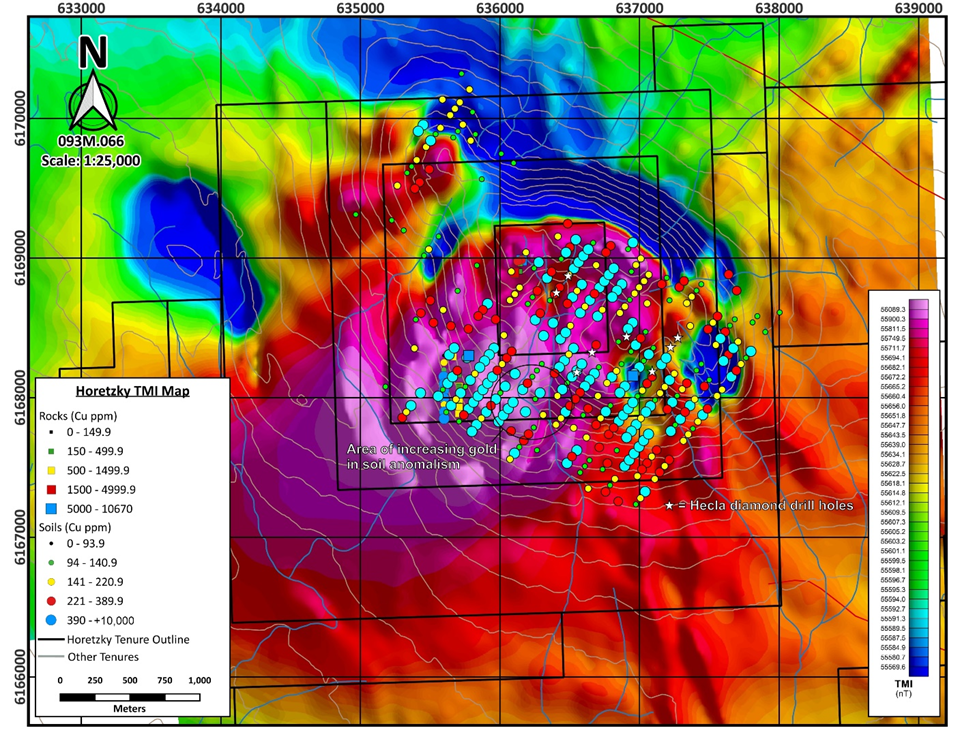Projects
Horetzky Copper Project
Project Geology
Premier Copper-Gold Opportunity in a Proven Mining District
Horetzky Copper Project: Unlocking Untapped Potential in British Columbia’s Babine Porphyry Belt
The Babine Lake region has been a focus for porphyry copper exploration since the early 1960s, leading to the discoveries of the Bell and Granisle copper deposits—two of British Columbia’s key copper producers. This success triggered extensive regional exploration, including the staking of the Mount Horetzky property by Falconbridge Mines in 1965.
Subsequent work by Hecla Mining (1967–1968) included geological mapping, prospecting, and soil sampling, which led to the identification of several copper-in-soil anomalies. In the 1972/1973 season, Hecla completed an airborne magnetic and electromagnetic survey, outlining a strong, semi-circular magnetic anomaly that correlates with a copper-molybdenum soil anomaly and multiple EM conductors—highlighting a highly prospective target for further exploration.
Surface geochemistry on total magnetic intensity airborne magnetics
Geology & Mineralization: A Strong Comparison to Babine’s Premier Deposits
The Horetzky Copper Project exhibits key geological characteristics seen in major deposits of the Babine porphyry copper belt. The presence of Eocene-aged Babine intrusions and coeval dykes has resulted in widespread hornfelsing and hydrothermal alteration within surrounding volcanic and sedimentary rocks.
Notably, mineralization includes:
- Chalcopyrite
- Molybdenite
- Bornite
- Chalcocite
These are hallmark indicators of a robust copper-gold porphyry system, reinforcing the project’s potential for a significant discovery.
Comprehensive Historical Data & Untested Expansion Potential
Northern Lights’ compilation of historical data reveals extensive prior exploration efforts, including:
- 27.5 line km of Induced Polarization (IP) surveys
- 521 line km of airborne magnetic and radiometric surveys
- 1,128 soil samples collected
- 76 rock samples analyzed
Despite this groundwork, drilling on the Horetzky Project remains limited, with only eight diamond drill holes completed by Hecla Mining in 1973. Available drill logs confirm that three of the eight holes tested a large IP anomaly, while another three intersected a copper-in-soil anomaly, returning copper mineralization at depth.
A 1992 assessment report by Rio Algoma states:
- The main copper and IP anomalies remain largely untested by historic drilling.
- A large, untested copper anomaly (1,000 x 300 meters) lies south of the 1973 drill area.
- Selective re-assaying of preserved core confirmed widespread anomalous copper, with notable results including:
- 4,370 ppm Cu over 0.91m
- 1,345 ppm Cu over 10.67m
Expansion-Ready Copper-Gold Anomaly with Strong Geophysical Signatures
The project hosts a 3.0 km² copper-in-soil anomaly, with multiple samples returning over 1,000 ppm copper, up to a maximum of >10,000 ppm Cu. This anomaly remains open for expansion, particularly:
- To the southeast
- Strongly to the southwest, where it correlates with a high-intensity magnetic anomaly—potentially indicating a zone of potassic alteration, a key feature of large porphyry copper systems.
Gold Potential: An Untapped Upside
While historical programs did not systematically analyze for gold, more recent assays have confirmed the presence of gold, including:
- Rock samples with >1% Cu and 277 ppb Au
- Soil samples returning up to 1,085 ppm Cu and 440 ppb Au
These results suggest that gold may represent a significant, underexplored component of this porphyry-style system.
Strategic Location in a World-Class Mining Belt
The Babine porphyry copper belt, extending 80 kilometers, hosts multiple major deposits, including the past-producing Bell and Granisle mines. Recognized as one of British Columbia’s most important mineral districts, the region is characterized by:
- Eocene Babine intrusions, which serve as the primary host rocks for porphyry copper-gold deposits.
- Late Cretaceous Bulkley intrusions, also known for their strong mineralization potential.
Conclusion
With a well-defined, large-scale copper-gold target, strong geophysical anomalies, and drill-confirmed mineralization, the Horetzky Copper Project represents a high-impact exploration opportunity in a proven mining district. Limited historical drilling and untested high-priority anomalies provide significant potential for a major new discovery.
Now is the time to unlock the value of this underexplored porphyry copper-gold system in one of British Columbia’s most prolific mineral belts.

